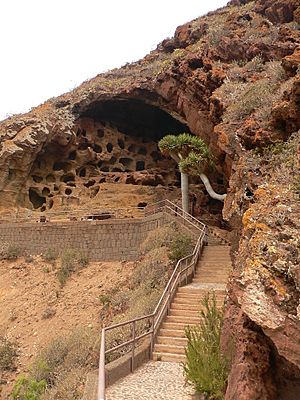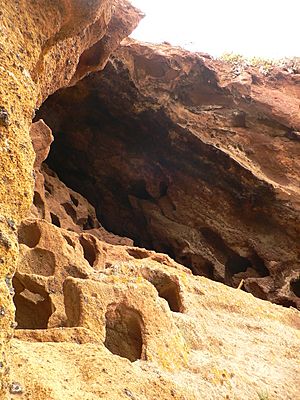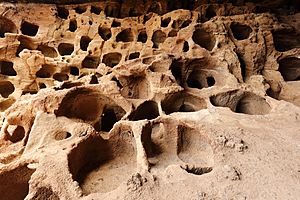Caves of Valeron facts for kids
Quick facts for kids Caves of Valeron |
|
|---|---|
| native name: Cenobio de Valerón ("Monastery of Valeron") |
|

General view of the caves
|
|
| Location | Santa María de Guía municipality, Grand Canary, Canary Islands (Spain) |
| Elevation | 275 m (902 ft) |
| Website | Cenobio de Valeron |
| Caves of Valeron | |
|---|---|
| Native name Spanish: Cenobio de Valerón ("Monastery of Valeron") |
|
| Lua error in Module:Location_map at line 420: attempt to index field 'wikibase' (a nil value). | |
| Type | cave |
| Nearest city | Gáldar |
| Original use | Collective granary |
| Official name: Cenobio de Valerón ("Convent of Valeron") |
|
The Caves of Valeron (in Spanish Cenobio de Valerón) are an amazing archaeological site on the Spanish island of Grand Canary. They are found on Valerón's cliff, in the area of Santa María de Guía.
These caves form the largest ancient granary built before Roman times. People on the island used them to store their food until the Spanish arrived in the late 1400s. The site is close to the famous Gáldar Painted Cave. It is a very important historical place in Grand Canary and is protected as a Spanish Property of cultural interest.
Where are the Valeron Caves?
The Caves of Valeron are located about 600 meters (about 2,000 feet) south of the northern coast of Gran Canaria. You can find them along the small GC-291 road. They are about 23 kilometers (14 miles) east of Las Palmas and 11 kilometers (7 miles) southwest of Agaete. The town of Gáldar is about 4 kilometers (2.5 miles) to the west.
This spot was chosen for a few good reasons. The rock here, called tuff, is soft and easy to dig. The caves are also hidden from the sea. Plus, the slopes leading up to them are very steep, making them a great natural defense.
What are the Valeron Caves like?
The Valeron Caves are a huge system of storage rooms, spread out over many levels. There are 298 separate spaces, each about one to three square meters in size. These are arranged on 8 different levels. In total, counting all the silos, rooms, and other cavities, there are more than 350 places to store things!
These spaces were dug out using tools made of stone and wood. They are located in the soft volcanic rock on the side of a mountain called "Montaña del Gallego." The natural arch in the mountain offered shelter. The cool, damp conditions inside were perfect for keeping crops fresh.
The storage caves come in many shapes and sizes. Some even connect to each other. Steps carved into the rock are still visible today. People likely used wooden stairs, scaffolding, or ropes to reach the higher levels.
The caves were closed off with doors to protect the food. We don't know exactly what these doors were made of, but they left marks. They might have been wood, stone slabs, or even soft materials like fabric or leather. Some stone slabs have been found. When wooden doors were used, they might have had a special seal, called a pintadera, to show who owned the stored goods. All the openings were sealed with a special ash mixture to keep the crops safe.
Inside the site, archaeologists have found old statues, paintings, pottery, and even human bones and ashes. These might have belonged to the people who guarded the granary. Old stories from the time of the Spanish conquest even mention towers around the caves.
The huge size of these caves shows how important farming was on Gran Canary. It wasn't just for food; it also showed the power of the island's leaders. Unlike other Canary Islands that focused on raising animals, Gran Canary grew a lot of crops, especially grains.
Why is it called a "Monastery"?
The name "monastery" comes from an old belief. Romans thought that celibate priestesses, called "harimaguadas", lived here. They believed that young noble women would come to live with them until they got married. This idea was popular until the 20th century.
Then, a French archaeologist named Guy Marcy realized the caves were actually used for storing food. This was similar to other structures found on the island and in North Africa. Old records also mentioned that people stored food in hard-to-reach rocky places. In North Africa, similar granaries called agadirs often had a shared storage area, guarded by the community.
Other Similar Places
There are other ancient granary sites on Gran Canary that are similar to Valeron. These include:
- King's caves (cuevas del Rey) and Bentayga Rock (Roque Bentayga) in Tejeda
- Caves of the Granary (cuevas del Pósito) near Temisas, Agüimes
- El Álamo site near Acusa, Artenara
- The Numerous caves (cuevas Muchas) in the Guayadeque ravine (barranco de Guayadeque), Ingenio
- Anzofé site near Gáldar
- La Montañeta near Moya
- Caves of the Dove (cuevas del Palomar) near Tabuco, Ingenio
- La Isleta near Las Palmas
- Barranco de Silva near Telde
- Small Dragon caves (cuevas del Draguillo) in El Gamonal (Telde), between Telde and Ingenio
- Los Pilares cave in the Four Doors cave site, Telde complex near Telde
- Tara site in Telde
- Temisas in Aguimes
- Rosiana site in San Bartolomé de Tirajana
- Cueva de la Audiencia in the Four Doors cave site on Bermeja mountain, Telde
- Birbique in Roque Bermejo, Agaete
Most of these sites are found in the northern parts of the island. While some caves are isolated, many are grouped together, often near the coast. The largest granaries are close to the two main ancient towns: Telde and Gáldar.
Protecting the Site
Valerón's "Monastery" was officially declared a Historical Artistic Monument on October 14, 1978. Because of a later law, it is now considered an "Archaeological site" and a Property of cultural interest. The site belongs to the local government of Santa María de Guía.
In 2010, a big project was started to restore the site. This included fixing the old San Felipe footpath that locals used to reach the caves. The site was closed for two years during this work.
Today, the Caves of Valeron are open to visitors as an archaeological park. It is part of a network of archaeological parks on Grand Canary. This network also includes other important sites like the Arteara necrópolis in Fataga, the necropolis in Agaete, the Cañada de Los Gatos near Mogán's beach, Bentayga Rock in Tejeda, the Guayadeque ravine in Ingenio, the Painted Cave in Gáldar, and the Four Doors cave site in Telde.
How to Visit
To get to the Caves of Valeron, you usually take the GC-291 road. The easiest way to access this road is from exit 20 on the GC-2 highway. This highway connects Agaete (about 11 km or 7 miles northeast) and Las Palmas (about 23 km or 14 miles west). Signs for the "cenobio de Valeron" are usually visible at exit 20. The site is about 4 km (2.5 miles) from this exit.
The site is open for visits from Tuesday to Sunday throughout the year. However, it is closed on some special holidays like Christmas. For safety and to protect the caves, visitors cannot go inside the actual storage compartments. The whole area is fenced and closed at night.
After the recent restoration work, the site now has a special path for visitors. Along the path, you'll find information panels, models, and other displays to help you learn about the caves.
Images for kids
See also
 In Spanish: Cenobio de Valerón para niños
In Spanish: Cenobio de Valerón para niños




